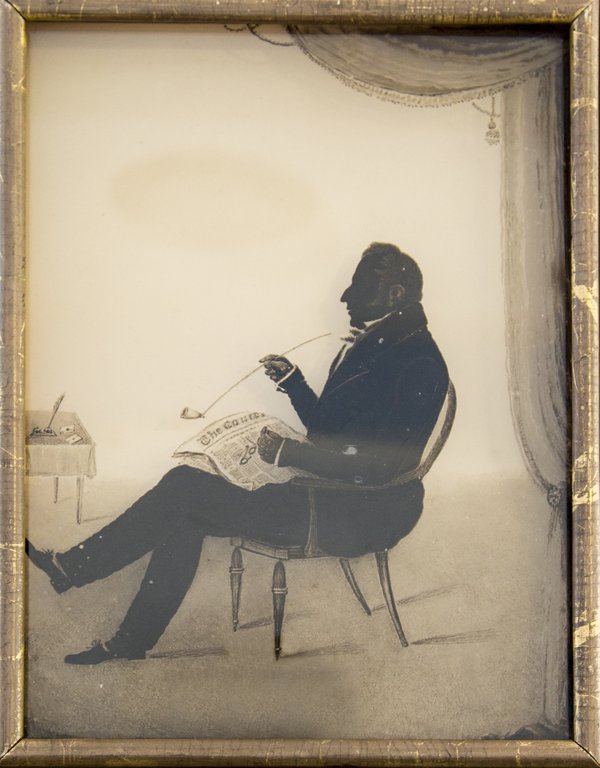Silhouette portraiture
Silhouette Portraiture, (1821): Drawing, ink on glass, entitled ‘Silhouette of Dr. Thomas Masterman Winterbottom’, by the artist John Woodhouse
All about this activity
Take One Treasure is a creative activity focusing
on a selected item from the collections of South
Shields Museum and Art Gallery.
The activities are in three parts to be completed over a three-week period, but learners can work at their own pace.
You can use materials such as paper, pencils, tape or glue, magazine or newspaper clippings and anything else you can find. Check you have permission before using.
At the end of each activity we ask you take a photograph of your work and email it to us to be included in our Online Art Gallery on our Facebook page.
Have fun and we look forward to seeing your creative Treasures.
You can download your Take One Treasure Silhouette Portraiture activity sheet here.
What is Silhouette Portraiture?

What is Silhouette Portraiture?
-
Silhouette (profile) portraiture was a way to recreate an image of oneself or loved one before the invention and common use of photography.
-
Silhouettes were usually made of paper or on glass.
-
Artists would either paint or cut these silhouettes using black paint or ink, and scissors, A fine needle was sometimes used in order to cut away fine detail where a scissor could not reach.
-
The work would be displayed on a light background to give definition to the outline.
-
Other names for this process were shadow portraits, black profiles and scissor-types, but the name that caught on was ‘silhouettes’.
-
It is thought that the Greeks and Romans perfected this process through casting shadows using different forms of light, such as sunlight, lamplight and candlelight to capture a likeness.
Activity 1 - Draw
Draw the silhouette (outline of shadow) of different objects you find around the house using different light and techniques.
- Experiment with different forms of light to see what produces the most detailed shadow, for example; sun, lamp, flashlight etc.
- Colour in your silhouettes black and cut them out.
- Experiment with different ways of cutting. Try scissors, tearing and a needle. PLEASE ASK AN ADULT FOR HELP.
- Attach your silhouettes onto a white or light background.
TIP: try posing dolls and stuffed toys
Make a silhouette profile of someone in your house. Ask someone to make one of you too.
Notice the empty space in the paper after you have cut out your silhouette. This image is called a negative.
- Try and experiment with different backings for both the negative and the silhouette.
Activity 2
Look closely at the silhouette of Dr. Winterbottom.
- What is he doing? How has he been portrayed?
- What objects do you see in this portraiture? What do they tell you about this man? Why do you think he chose them?
- The artist would have sat Winterbottom sideways in a dark room and positioned his bright light 3 or 4 meters away so that the shadow fell sharply onto the surface he was painting. Standing beside Dr. Winterbottom, he would then draw around the shadow.
Create a full body silhouette portraiture of someone you know.
- Think about the objects you would include. Are they important, representative, valuable, sentimental, out of the ordinary, show the person’s interests, etc.?
Ask a household member to help create one of you.
- What objects are important for you to include?
Challenge Activity: Shadow play
What is shadow play?
- Shadow play, also known as shadow puppetry, is an old form of storytelling and entertainment which uses flat articulated cut-out figures which are held between a source of light and a see-through surface.
- They are made of separate pieces that are held together with strings or wires. The strings or wires are usually attached to long rods that control the movement of the puppet.
- Moving the puppet creates the illusion of moving images on the screen. You can make figures appear to walk, talk, fight and dance.
- This BBC Bitesize video shows you how to make shadow puppets and gives a history of shadow puppetry.
Have a go at turning your silhouettes into shadow puppets or create some from your imagination. You can also use your hands to make shadow figures. This link to blifaloo.com shows you how.
- Experiment with sheets, ceilings, and walls to cast your puppet shadows.
- Make a shadow puppet theatre and put on a play!
Activity 3 - The art of the word
Create lists of words that describe your silhouette pictures or the one of Dr. Winterbottom.
- Think about the lighting, shapes, space, etc.
- Imagine the person’s thoughts, the scent and textures of the objects, the temperature and sounds in the room.
Write a play for your shadow puppets, or a poem or story using the vocabulary for inspiration.
Share your work with us
Share what you have created with us - email us images or words to sslm@twmuseums.org.uk to help us create an online Facebook Gallery, by using @S_ShieldsMuseum #SSMAGatHome on Twitter.



